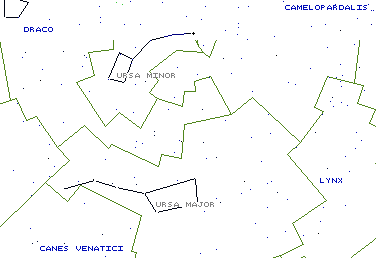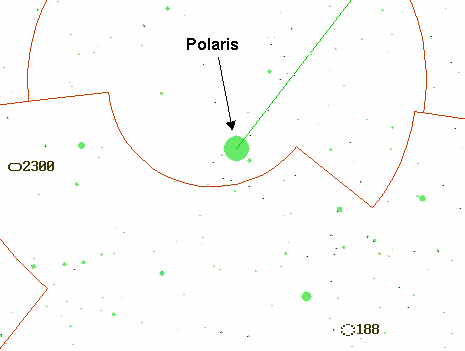A Trip to the North Pole
Jack Kramer
What could be more appropriate for the holiday season than a trip to the North Pole? But instead of visiting the jolly old man in the red knickers, we're going to take a look at the north pole itself ... in the sky. As you know, the North Star (Polaris) is close to being at the north point in our sky -- the axis around which the sky appears to rotate. Aim the polar axle of your equatorially-mounted scope at Polaris and you'll be pretty well polar aligned. But not perfectly. If you have to do some very exact guiding, then you need to aim at true north, which is offset from Polaris by about 1o. If you can wait until the year 2100, precession will have brought it only a half degree from true north.
On a more elementary level, Polaris is probably the first star that people learn to recognize. Everyone knows about the "North Star". But while we may use the pointer stars of the Big Dipper to locate it, Polaris is actually in the constellation of the Little Dipper...not the Big Dipper, as illustrated in the diagram below that includes the constellation boundaries.

At about magnitude 2.0, Polaris is the 49th brightest star in our sky. It's also an easily-split double, with a 9th magnitude blue-colored companion. The primary star is slightly variable, and variations in its radial velocity indicate the presence of an additional, unseen, companion star. Observing Polaris itself can be an ordeal with a scope on an equatorial mount because you have to try to locate it while rotating the tube about the polar axle, but with a Dobsonian it's a snap.
While we're in the area, there are some deep sky objects close by in the constellation Cepheus, which is well-placed this time of year. NGC 188 is an open cluster of about magnitude 8.0. In the 10-inch it appears almost circular in outline with an abundance of faint stars and some concentration toward the center. In a smaller telescope, it appears as a small, round hazy patch; my records show I had also seen it in a 70mm copyscope. NGC 188 is of special interest because it is the oldest known galactic star cluster. Its stars are typical of what would be found in globular clusters, which tend to be older than galactic ("open") clusters. But NGC 188 is even older than many globulars. (The following chart is from the Guide computer program. The line extending from Polaris indicates the direction of Ursa Minor.)

NGC 2300 will be more of a test. It's a 12.5 magnitude galaxy; the relatively large size of 3.2'x2.7' spreads its light rather thinly, which results in a low surface brightness. I've looked for it several times with my 10-inch from observing sites in Illinois, to no avail. You'll need a dark sky and probably more light gathering power than I can muster.
In addition to the deep sky objects cited here, there are a few other galaxies in the area, but they're in the range of 14th magnitude. That should be just accessible with a 10-inch scope in dark skies. But those whose light is concentrated in a smaller area may prove easier to find than NGC 2300. If you'd like to take on a worthy challenge, use a computer program such as Guide or get out a Uranometria and give these galaxies a whirl.
Happy holidays from the North Pole...and HO-HO-HO!
Published in the December 1998 issue of the NightTimes




